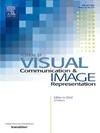用于人体活动识别的时空三维骨骼运动关节点分类模型
IF 3.1
4区 计算机科学
Q2 COMPUTER SCIENCE, INFORMATION SYSTEMS
Journal of Visual Communication and Image Representation
Pub Date : 2025-05-11
DOI:10.1016/j.jvcir.2025.104471
引用次数: 0
摘要
由于背景混乱和动作复杂等因素,视频数据中的人类活动识别具有挑战性。这项工作引入了堆叠集成3D骨骼人体活动识别(SES-HAR)框架来解决这些问题。该框架利用MoveNet闪电姿态估计来生成2D骨骼运动学关节点,然后使用高斯径向基函数核将其映射到3D。SES-HAR采用两层的堆叠集成方法:0级基础学习器和1级元学习器。基础学习器包括卷积两部分长短期记忆网络(Conv2P-LSTM)、带注意的空间双向门控时态图卷积网络(SBGTGCN)和卷积极限梯度增强(ConvXGB)。它们的输出由一级的逻辑回归(LR)元学习器进行汇总和处理,以生成最终的预测。实验结果表明,SES-HAR在NTU-RGB + d60、NTU-RGB + d120、Kinetics-700-2020和Micro-Action-52数据集上取得了显著的性能提升。本文章由计算机程序翻译,如有差异,请以英文原文为准。
Spatio temporal 3D skeleton kinematic joint point classification model for human activity recognition
Human activity recognition in video data is challenging due to factors like cluttered backgrounds and complex movements. This work introduces the Stacked Ensemble 3D Skeletal Human Activity Recognition (SES-HAR) framework to tackle these issues. The framework utilizes MoveNet Lightning Pose Estimation to generate 2D skeletal kinematic joint points, which are then mapped to 3D using a Gaussian Radial Basis Function Kernel. SES-HAR employs a stacking ensemble approach with two layers: level-0 base learners and a level-1 meta-learner. Base learners include Convolutional Two-Part Long Short-Term Memory Network (Conv2P-LSTM), Spatial Bidirectional Gated Temporal Graph Convolutional Network (SBGTGCN) with attention, and Convolutional eXtreme Gradient Boosting (ConvXGB). Their outputs are pooled and processed by a Logistic Regression (LR) meta-learner in the level-1 layer to generate final predictions. Experimental results show that SES-HAR achieves significant performance improvements on NTU-RGB + D 60, NTU-RGB + D 120, Kinetics-700–2020, and Micro-Action-52 datasets.
求助全文
通过发布文献求助,成功后即可免费获取论文全文。
去求助
来源期刊

Journal of Visual Communication and Image Representation
工程技术-计算机:软件工程
CiteScore
5.40
自引率
11.50%
发文量
188
审稿时长
9.9 months
期刊介绍:
The Journal of Visual Communication and Image Representation publishes papers on state-of-the-art visual communication and image representation, with emphasis on novel technologies and theoretical work in this multidisciplinary area of pure and applied research. The field of visual communication and image representation is considered in its broadest sense and covers both digital and analog aspects as well as processing and communication in biological visual systems.
 求助内容:
求助内容: 应助结果提醒方式:
应助结果提醒方式:


